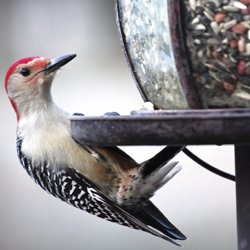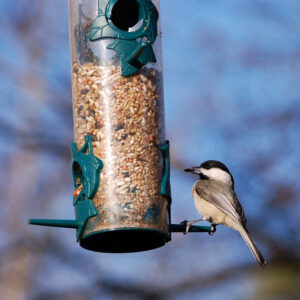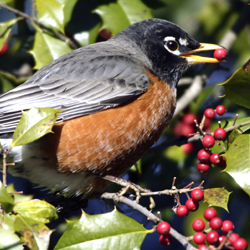Birds are fascinating. They can also be your secret weapon in your pest management program by eating your insect pests. Invite them in and keep them around. A well-planned three part “bird program” will be the perfect welcome to your feathered friends. Providing food, water and shelter is just the ticket.
Food
Just like people, birds eat different foods and prefer different feeders. Establishing several types of food stations with different foods will entice a variety of birds to visit your “buffet.” Make them feel secure and comfortable by locating the feeders close to bushes and trees to allow escape from predators.
Use a hummingbird feeder to attract Allen’s, Anna’s, Rufous, Costa’s and black-chinned hummingbirds. You may prepare the nectar by mixing one part white granulated sugar (no other kind of sugar) with four parts water, and heat until the sugar totally dissolves. Cool and fill your feeder. No food coloring is required, as the red of the feeder will attract the tiny birds. Consider purchasing prepared hummingbird nectar to always have it on hand and avoid the kitchen hassle and mess.
Hang or mount suet feeders to attract woodpeckers, nuthatches, chickadees and other birds appreciative of the high-energy fat in the winter or during nesting season. Many styles and mixtures are available but they all resemble cages enclosing a solid cake of food. If squirrels are a problem, choose a style with a roof or baffle. If the squirrels are persistent, you can establish a squirrel feeding station to divert them from the birds.
Offering a seed mixture such as “Wild Delight Deck, Porch n’ Patio” in your feeder satisfies the choosiest of birds. This specially formulated product attracts a wide assortment of birds while avoiding the mess of shells or sprouting seeds. Use it in different types of feeders such as:
- Tube feeders: Hanging or mounted to a wall or tree, these come in a variety of sizes to hold different types of seeds. “Thistle feeders” or “finch feeders” are small and hold nyjer- thistle seeds, attractive to the smaller finches. Fill larger ones with birdseed mix or black-oil sunflower seeds for the larger birds.
- Ground or platform feeders: These are located closer to the ground and are between a few inches to 3′ from the ground to attract ground-feeding birds. The style with a bottom screen will allow rain or other water to drain. To attract doves, pigeons, ducks, sparrows, juncos and red-winged blackbirds, fill with millet mixed with corn and black-oil sunflower seeds.
- Fly-through and hopper feeders: These are hung or mounted on a pole or deck 5-6′ above the ground. Black-oil sunflower seeds attract Steller’s Jays, finches, Nuthatch and chickadees.
- Block feeders: Similar to the suet feeder, the solid food block contains seeds and fruit.
Your landscaping can also provide food to your feathered friends. Attract hummingbirds with red, pink, blue, purple, orange and white flowers. Fuchsias, agastache, agapanthus, delphinium, hollyhock, trumpet and cardinal vines are just a few. Other birds will appreciate berries (especially in the winter) from trees and shrubs such as Berberis, cotoneasters and privets, among many others. Many flowers also attract birds. Consider planting Dame’s Rocket, foxgloves and Oriental poppies, just three of many.
Water
Birds require water to drink and for baths. Birdbaths, shallow pools and the sounds of dripping water attract them. Birds prefer birdbaths with rough edges to avoid slipping. A water depth of only 1″ is sufficient. Again, site the water source near protective shrubbery in case of predator attack. Regularly cleaned basins will receive the most visitors.
Shelter
Birds need shelter from bad weather and predators. Put out the welcome mat by including hedges, trees, and shrubs of different heights and density in your landscaping. During the nesting season, some birds will appreciate nesting boxes. The size of the box, the size of the entrance and its height from the floor of the box are specific to different birds.
With very little effort and expense, you’ll be the birds’ BFF (best friend forever).









